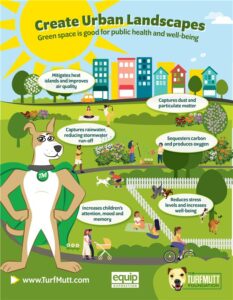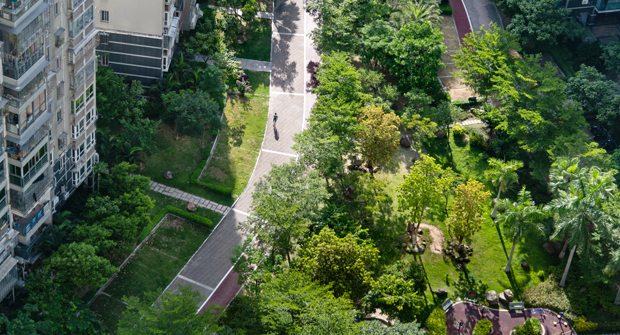The TurfMutt Foundation advises communities to invest in green space for the health and well-being of citizens. The experience of taking indoor activities to the outdoor areas around us such as dining, working, exercising and entertaining, led the TurfMutt Foundation to coin the term “backyarding.”
“In light of the growing importance of being outside, we’re seeing more communities invest in parks and other community green space as the best amenity to offer their residents,” said Kris Kiser, president and CEO of the TurfMutt Foundation and the Outdoor Power Equipment Institute (OPEI). “They are advancing the concept of backyarding at home now into more public green spaces.”
Kiser, an advocate for outdoor living and the care of green space for the past 15 years, says the city of Louisville is a prime example.
“The TurfMutt Great Lawn and Mulligan’s Bark Park in downtown Louisville exemplify how cities can embrace urban greening to enhance their residents’ quality of life while also improving the environmental health of the community,” Kiser said. “We encourage more communities to take Louisville’s lead and make these important investments.”

According to the TurfMutt Foundation, here are the top five reasons why communities should invest in urban living landscapes for “public backyarding” activities:
The physical health of your community benefits
Researchers from USDA found associations between urban green space exposure and reduced mortality, heart rate and violence. Visits to parks, community gardens and other green spaces could lower city dwellers’ use of medications for anxiety, insomnia, depression, high blood pressure and asthma, according to the Finnish Institute for Health and Welfare.
Mental well-being goes up when there’s more green space exposure
People who visited urban parks for just 21 minutes showed a decrease in cortisol levels and reported increased well-being, according to a study conducted in Alabama.
Researchers found that passive nature engagement and greenness around schools and in urban parks can positively impact children’s attention, mood and memory. Having nearby urban green space is positively linked to the development of pro-social behaviors in children and adolescents.
Environmental benefits
Urban green space helps alleviate heat islands, reduces storm water runoff and improves air quality.
Some communities are finding creative ways to green their communities. These efforts include green roofs on Boston bus shelters, greening of neglected alleys in urban Detroit and the creation of pocket parks in New York.
Planting more trees in cities could cut deaths from summer heat, according to a European study that shows increasing urban tree coverage to 30 percent can lower temperatures by as much as 32 degrees F.
Financial benefits stem from green space
According to the U.S. Forest Service, the nation’s urban canopies — which are home to an estimated 5.5 billion trees — provide roughly $18 billion in annual benefits through the removal of pollution from the air ($5.4 billion), carbon sequestration ($4.8 billion), reduced emissions ($2.7 billion) and improved energy efficiency in buildings ($5.4 billion).
According to research from the University of Washington, people shop more frequently, take longer shopping trips and are willing to spend 12 percent more for goods in tree-lined commercial districts.
Green space reduces crime.
According to an article in Proceedings of the National Academy of Sciences, landscaping in vacant lots has been shown to lessen overall crime by more than 13 percent, reduce burglary by 22 percent and reduce nuisance reports by 30 percent.
To find the studies referenced and to learn more, download the TurfMutt Foundation’s International Backyarding Fact Book.


